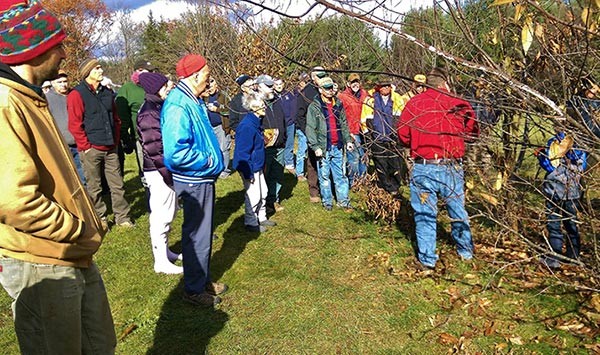During the first decade of the 20th century, New York Harbor teemed with steamships delivering new arrivals from overseas. Between 1900 and 1910, the Statue of Liberty welcomed an average of nearly 645,000 immigrants per year, more than the present-day population of Vermont. Families from all across Europe flowed through a processing station on Ellis Island, bringing vitality and diversity to the city and beyond.
But transcontinental shipping brought more than people to the boroughs of New York that decade. One new arrival that passed quietly through the clamor was chestnut blight, a pathogenic tree fungus accidentally imported on nursery stock from Japan. The blight would soon drain life from over 200 million acres of forest stretching from Mississippi to Maine. Within fifty years of its first detection at the Bronx Zoo in 1904, the virulent fungus had reduced one of America’s most abundant and useful canopy trees to a minor component of the understory. Today, seedlings, stump sprouts, and diseased poles persist in some forests, but few American chestnuts survive to maturity within the species’ pre-blight range.
The America Chestnut Foundation (TACF) is one of several organizations providing leadership in the effort to restore this iconic species to the eastern forest canopy. Members and staff of TACF are collaborating with state and federal agencies, universities, and individuals to develop a blight-resistant American chestnut through hybridization and other methods.
Earlier this month, about forty people gathered at New Hampshire’s Shieling Forest on a misty morning for a landowner workshop titled “American Chestnut Orchards on Private Land.” The event was organized by the New Hampshire Timberland Owners Association (NHTOA) and co-sponsored by TACF, Northern Woodlands, and the New Hampshire Division of Forests and Lands. It opened with a presentation by TACF’s New England Regional Science Coordinator, Kendra Collins, and continued with tours of two restoration orchards led by A.J. Dupere, a forester with the state’s Urban and Community Forestry program.
Together, Collins and Dupere described the scientific rationale and practical challenges of backcross breeding, a technique that involves hybridizing native American chestnuts with blight-resistant Chinese chestnuts and then backcrossing the hybrids with American chestnuts. This method is performed over multiple generations – and at multiple locations – in order to produce a predominantly native and locally adapted variety that can withstand the disease. It’s a long-term endeavor, requiring heavy doses of patience and site maintenance. Since initiating the program 35 years ago, TACF has worked with partners to establish restoration orchards in 16 states, with an eye toward the project’s “Johnny Appleseed” phase, when forest plantings may begin.
Meanwhile, complementary research initiatives have sprung up throughout the East, with scientists working to add biological control and genetic engineering to the restoration toolkit. Even as researchers make groundbreaking discoveries in clean labs, the restoration effort will continue to depend on volunteers ready to break actual ground – orchard keepers who dig, plant, weed, and defend saplings from harm. The role calls for individuals with a high tolerance for delayed gratification, willing to work for a still-distant new beginning. . . the kind of people who recently huddled beneath the branches of chestnut trees at Shieling Forest.
To learn more about The American Chestnut Foundation’s regional breeding initiative, click here. For more information about NHTOA’s educational offerings, contact Program Director Steve Gaines.



Discussion *